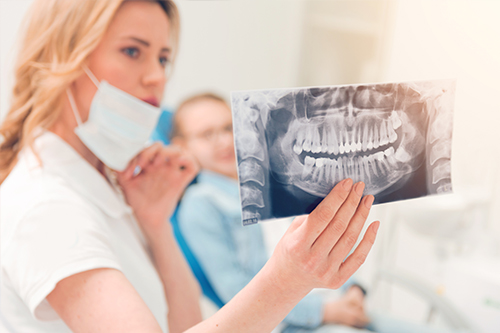


3D imaging is used by dental professionals to analyze and reconstruct 3D images of a patient’s teeth, jaws, and surrounding anatomy. The information obtained by means of 3D imaging is useful in both diagnosis and precise treatment planning, where two-dimensional diagnostic films are insufficient. Dental 3D imaging is useful for multiple types of analyses, as well as the assessment of maxillofacial disorders or pathology. It is also utilized for surgical planning, including the accurate placement of dental implants.

This remarkable technique requires only four implants in either the upper or lower jaw to support all replacement teeth for a dental arch. All-on-4®* typically involves only one surgery to place all the implants. This not only avoids the need for additional bone grafting procedures, but provides the instant gratification to the patient of receiving a full set of temporary teeth immediately.
As a permanent fixed replacement for all the teeth, All-on-4 dental implants achieve unprecedented results with a minimal number of dental implants and surgical procedures. Once post-surgical healing is complete and the All-on-4 dental implants have fully integrated with your jawbone, the temporary bridge is permanently replaced by your customized final bridge. This makes the procedure both an appealing and cost-effective solution for permanently replacing a full set of teeth. These new replacement teeth are completely secure and stable, as well as function in a similar fashion as natural teeth.
*All-on-4 is a registered trademark of Nobel Biocare.
Dental inlays and onlays offer an excellent alternative to “direct” amalgam or composite fillings to restore teeth that have sustained some damage, but not enough to require a full coverage crown. While “direct” fillings such as dental amalgam and composite fillings are placed immediately after the decay or damage is removed and the tooth is prepared, inlays and onlays are known as “indirect” fillings. This means that they are fabricated outside of the mouth prior to final bonding or cementation.
While in the past, many inlays and onlays were caste from gold; today’s dental inlays and onlays are typically custom made of either the highest grade of dental porcelain or composite resins. In addition to providing an exact match to the color of tooth for a cosmetically pleasing result, inlays and onlays have the distinct advantages of being more durable than other fillings, preserving more underlying tooth structure and actually strengthening the tooth so that it can bear up to 50 to 75 percent more chewing forces.
Inlays and onlays only differ from each other in the amount of tooth structure they cover. An inlay is fabricated when the replacement of tooth structure does not require coverage of any cusp tips. If the damage from decay or injury is more extensive and involves more of the tooth’s chewing surface, including one or more cusp tips, an onlay is required.
Both inlays and onlays are fabricated outside of the mouth based upon the exact specifications provided by an impression of the prepared tooth. The final inlay or onlay is then custom made by either a dental laboratory or in-office with a same day system.
We offer an advanced dental technology, which allows for the preparation and placement of same day ceramic restorations. Offering the utmost in terms of quality and convenience, this high-tech system eliminates the need for multiple dental visits, temporary crowns, as well as messy dental impressions.
Using this method, the tooth to be crowned is scanned, a restoration is digitally designed and then a permanent ceramic restoration is precisely milled in the dental office on that very same day.
The process utilizes CAD/CAM technology, or computer aided design and computer aided manufacturing. A single visit crown offers much more than a convenient approach to getting a dental crown. It is a high quality, naturally beautiful and extremely durable, permanent dental restoration.
Teeth that have been stained or darkened by food, tobacco use, age, medications or injury can be lightened and brightened by means of a non-invasive process known as teeth whitening.
Teeth whitening or bleaching simply refers to any process that will make the teeth appear whiter. While there are many over the counter options for teeth whitening, the most effective and safest teeth whitening systems are the professional strength ones available at the dentist’s office. A dental professional whitening system offers a higher concentration of whitening components and delivers them to the teeth in the most efficient manner to achieve optimal results.
At our office, we offer two exceptional options for tooth whitening. You can choose either an in-office tooth whitening procedure or a professional take home system. Both of these are top-of the-line systems. However, the biggest advantage of the in-office procedure is that in as little as one hour you can achieve a smile that is several shades whiter and brighter than the original color of your teeth.
Our professional strength take home system also produces excellent results. However, this is achieved by way of a more gradual process. Our take home kit may be prescribed alone, or after an in-office treatment to perfect or maintain the in- office result.
If your teeth suffer from gaps, chips, stains, or discolorations you may be a candidate for porcelain veneers, a highly effective and minimally invasive cosmetic procedure that can achieve beautiful results.
Porcelain veneers are thin facings custom-made of the highest quality ceramic materials that are designed to fit perfectly over the front of your teeth. One of the most conservative cosmetic treatments available, veneers can mask a host of dental imperfections to give you the smile that you have always wanted. Porcelain veneers not only enhance and improve the shape of your teeth, they are able to create an overall whiter and brighter smile.
One of the most appealing aspects of the process of fabricating porcelain veneers is that they involve minimal tooth preparation and take just a few visits. Porcelain veneers, once they are fabricated and fitted, are permanently bonded to the underlying teeth. The result is a naturally pleasing smile that is both strong and durable.
Recontouring or reshaping the teeth (also called odontoplasty, enameloplasty, stripping, or slenderizing) is a procedure in which small amounts of tooth enamel are removed to change a tooth's length, shape, or surface.
A dental emergency can arise for many reasons. It may be due to a traumatic oral injury, a cracked or fractured tooth, extensive tooth decay, a broken filling, periodontal abscess, dental infection, problematic wisdom tooth, or a painful soft tissue lesion- just to name a few. Whatever the case may be, it’s always a good idea to get a timely evaluation and prompt care. If left untreated, dental problems often worsen, leading to more serious consequences to your oral health and overall well-being.
And, while painful dental problems are typically the reason for an urgent dental visit, we also provide prompt care for broken dental appliances or dentures and dislodged crowns, which are frequently more unsightly and inconvenient than uncomfortable.
Pain is your body’s way of signaling that something is not quite right and though there are many reasons for oral pain, one of the most common complaints and reasons for seeking urgent dental care is a toothache. Whether you simply need a filling, a crown, or require a root canal procedure to save your tooth, we’ll alleviate your discomfort and restore the look and function of the involved tooth.
Dental trauma can result in a defect as minor as a small chip in tooth enamel to a more extensive and painful crack or fracture. With sufficient force, a tooth can even be displaced or completely knocked out of its socket. With prompt emergency care, many injured teeth can be restored and saved.
The last teeth in your mouth to develop, wisdom teeth often do not have enough room to fully erupt or may be positioned in the wrong direction. These issues can affect your dental health as well as overall well-being. Our office refers out our posterior extractions to Oral Surgeons that we know and trust.
A broken or lost dental prosthesis or restoration can cause embarrassing gaps in your smile as well as compromise your ability to eat and speak with ease. If you’ve lost or broken a dental filling, denture, crown, or other dental appliance, you can rely on our office to perform a prompt repair or provide a durable and cosmetically pleasing replacement as quickly as possible.
If your dental emergency is painful, if it affects the appearance of your smile, or if you suspect that an infection is present, our office will make every effort to see you as soon as possible for care. While emergency dental care is a service we hope you'll never need, you can rest assured that your oral health is in the best of hands at our office!
Prosthodontists are often called upon to treat the most difficult restorative and challenging cosmetic dental cases. Sometimes these cases involve multiple procedures to address complex dental problems that are affecting an individual’s entire occlusion. The term “full mouth reconstruction” is applied to these situations.
The process of full mouth reconstruction often involves rebuilding and/or replacing many, if not all of the teeth in the mouth, and can require the coordinated approach of a number of dental specialists. Candidates for full mouth reconstruction are individuals who have been cosmetically and functionally debilitated by extensive tooth loss, dental trauma, dental decay, dental habits, TMJ jaw-joint disorders, grinding their teeth, have suffered the effects of long-term acid erosion of tooth structure, or been affected by medical conditions or therapies involving the head and neck area. Additionally, individuals with congenital disorders that have dental manifestations like missing teeth or defective tooth structure may also be candidates for full mouth reconstruction.
We value the input of our patients and strive to fulfill their expectations of care. Dr. Lewandowski designs every smile virtually before he begins any work on a patient. As well as this, he provides a mockup for patient review and approval. By having a visual reference that patients can easily understand, it enables them to become more actively involved in their treatment process and fosters a trusting partnership in care.
Our goal is to not only achieve results that are vibrant and naturally beautiful, but to also create facial harmony and maintain functional balance. In developing the most effective treatment plan to enhance the appearance of a patient’s smile, several factors are taken into consideration. Overall facial form, the relationship of the lips to the teeth, tooth form, tooth size, and shade are all analyzed to develop the ideal approach to care. A cosmetically pleasing treatment outcome depends upon the successful integration of all of these elements.
For patients with “peg laterals,” which are undersized and peg-shaped top front teeth, a Harmonious Smile can be achieved with the fabrication and placement of custom-designed ceramic veneers. Permanently bonded to the underlying peg lateral incisors, these attractive, durable, and long-lasting restorations create a naturally beautiful smile.
Losing a tooth due to injury, dental decay, or gum disease can happen. However, in order to avoid causing problems for the adjacent teeth and your overall dental health, it is important to replace the tooth that has been lost. This can be done any number of ways including fixed bridges, removable partial or full dentures as well as a more recent procedure known as dental implants.
One of the most significant dental innovations in recent times, an implant is a small surgical fixture made of biocompatible metal or ceramic materials that is placed into the jawbone and functions in the same manner as the root of tooth. In the same way that natural root supports the natural crown of your tooth, an implant once it fully integrates with the surrounding bone, provides a stable and durable foundation for a replacement tooth. Implants often support a crown for an individual tooth, but can also be used as abutment teeth for a dental bridge, or strategically placed to help stabilize a denture.
Out of all the restorative choices available today, an implant comes the closest to replicating the look, feel and function of a natural tooth. Furthermore, it is the only method of tooth replacement that does not require the involvement or preparation of the adjacent teeth. A dental implant also stimulates bone remodeling to prevent shrinkage in areas where teeth are missing and helps to restore facial contours in areas where significant bone loss has occurred.
Whether an individual tooth or multiple teeth are missing, our practice offers the most advanced implant-basedsolutions to help patients reestablish complete and beautiful smiles.
At the office of J.A. Lewandowski, DDS, we are proud to have a full service dental lab on premises to provide the highest quality services and most convenient options in care to our patients. Our lab gives us the ability to customize a comprehensive range of dental restorations and prostheses, including inlays/onlays, veneers, crowns, bridges, partial or full dentures, and other appliances. We are also able to craft restorations that blend seamlessly with your smile while achieving healthy, functional, and long-lasting results. If you happen to damage or lose a dental restoration or appliance, you can rely on our office and in-house lab for prompt replacements or repairs.
To reduce any anxiety and insure patient comfort whenever a tooth extraction is necessary, the procedure, the post surgical instructions, as well as any restorative follow-up care will be carefully and completely explained.
Oral and Maxillofacial Surgery encompasses a wide range of procedures including:
Sometimes prior to the fabrication and placement of a dental prosthesis, certain oral surgery procedures such as sinus lifts, bone grafts, bone remodeling and tissue recontouring are needed to ensure the best outcomes of care. These procedures allow new dental crowns, dentures or dental implants to have the best fit and to achieve the maximum level of comfort as well as optimal function, and appearance.
With several years of advanced specialty training, Oral and Maxillofacial Surgeons are well trained in all types of dental anesthesia and sedation and can ensure patient comfort during surgical procedures.
When teeth are missing, a series of changes that can impact your overall dental health and jaw function may begin to develop. The adjacent teeth may start to drift or tilt into the space, and teeth in the opposing jaw may start to shift toward the area of the missing tooth. It is therefore important to replace either the single tooth or multiple teeth that are missing from this area. One of the best options to prevent the consequences of shifting teeth and to restore full function to a small edentulous section in the mouth is a dental bridge.
A dental bridge replaces the missing teeth with artificial teeth called “pontics,” and is supported on the ends by prepared natural teeth. Once fabricated and fitted a dental bridge will be permanently “fixed,” or cemented into place. Like crowns, bridges can be made of either porcelain baked on to a metal substrate or many of the new ceramic materials that have been developed.
Losing a tooth due to injury, dental decay, or gum disease can happen. However, in order to avoid causing problems for the adjacent teeth and your overall dental health, it is important to replace the tooth that has been lost. This can be done any number of ways including fixed bridges, removable partial or full dentures as well as a more recent procedure known as dental implants.
One of the most significant dental innovations in recent times, an implant is a small surgical fixture made of biocompatible metal or ceramic materials that is placed into the jawbone and functions in the same manner as the root of tooth. In the same way that natural root supports the natural crown of your tooth, an implant once it fully integrates with the surrounding bone, provides a stable and durable foundation for a replacement tooth. Implants often support a crown for an individual tooth, but can also be used as abutment teeth for a dental bridge, or strategically placed to help stabilize a denture.
Out of all the restorative choices available today, an implant comes the closest to replicating the look, feel and function of a natural tooth. Furthermore, it is the only method of tooth replacement that does not require the involvement or preparation of the adjacent teeth. A dental implant also stimulates bone remodeling to prevent shrinkage in areas where teeth are missing and helps to restore facial contours in areas where significant bone loss has occurred.
Whether from disease, malnutrition, genetic disorders or an accident, it is occasionally necessary for patients to have some or all their upper and lower teeth extracted. While this can be upsetting news, partial or full dentures can be fabricated to restore an attractive smile, provide needed support for normal facial contours, and reestablish a highly functional occlusion.
A denture consists of natural looking artificial teeth set in a supportive base. It may be fabricated to replace either a small group of teeth, an entire upper arch, an entire lower arch, or used to restore both dental arches.
A complete denture refers to the replacement of all the teeth in a dental arch. It can be inserted either of two ways. It can be inserted some weeks after the extraction sites and other surgical procedures have had a chance to heal, or as an “immediate” denture placed the same day the last remaining teeth are extracted. Although an immediate denture offers the advantage of not having to go without teeth for any length of time, it can require multiple adjustments as the tissues remodel and heal following dental extractions or other surgical procedures.
In situations where some sturdy teeth remain, partial dentures can be fabricated. Partial dentures can achieve adequate retention and stability by having clasps on the teeth surrounding the edentulous areas.
In some cases, added stability for the dentures can be provided by strategically placed implants.
Dental Fillings are the most common type of dental restoration used to replace sections of teeth that are missing, damaged or decayed. While traditional dental materials like gold, amalgam, porcelain, and composite successfully restore teeth; recent advances in dental technology have made a wider and improved selection of restorative choices available. Some of the newest state-of-the-art filling materials, including ceramic and the latest composite materials, are not only strong and durable, they offer the most aesthetically pleasing and natural looking results.
The terms dental crowns and caps are synonymous. If dental decay, cracked fillings, root canals, clenching or grinding the teeth have caused extensive damage to the underlying tooth structure a dental filling may not be a sufficient restoration. The only way to completely restore the cosmetic appearance and function of this tooth is often full coverage with a dental crown. The good news is that a completed dental crown looks and feels like a natural tooth.
In addition to restoring a single natural tooth, crowns can be used in other situations including being the supporting ends of dental bridge, covering dental implants, or as coverage for a cracked tooth to prevent further breakdown. A crown may also be indicated when a discolored or stained tooth needs to be restored to its natural appearance. Crowns can be made of either porcelain baked onto a metal substrate, all-porcelain, or many of the new ceramic materials that have been developed.
Endodontics, or root canal therapy, is employed when the nerve supply to a tooth has been irreversibly affected by damage or decay. It is a way to prevent or help resolve a dental infection and save a natural tooth from extraction. A root canal is performed when there is enough sound root and crown structure remaining to eventually restore form and function to the involved tooth.
Inside every tooth is either a single central chamber or multiple ones that contain connective tissue, a nerve supply, and blood vessels. These core tissues, known as the dental pulp, help your tooth to grow and mature before it emerges into the mouth. A root canal procedure is required when this dental pulp is irreversibly damaged or has died.
Root canal therapy involves cleaning and shaping each canal, and then filling them with a special inert material. Following this they are sealed to prevent any subsequent infection. Once root canal therapy has been completed, the tooth should be fully restored as recommended.
We offer conscious sedation.
Sedation dentistry offers individuals with general anxiety about going to the dentist or fears about a specific dental procedure the opportunity to have a stress free and more comfortable experience. Utilizing safe and controlled sedation techniques prior to the dental procedure the patient is eased into a state of complete relaxation. This eliminates any discomfort, pain, and preoperative anxiety that may be associated with a particular dental visit. With sedation dentistry patients typically feel more at ease post-operatively as they have little or no memory of the actual moment-to-moment dental procedure. Should you require sedation services outside of our normal scope, we work with a company specializing in Anesthesia.
Commonly referred to as “laughing gas,” nitrous oxide is used as a mild sedative to reduce anxiety and allow a level of relaxation during a procedure. Nitrous oxide is inhaled through a small mask over the nose. It is administered for the duration of the procedure and is turned off as the procedure is coming to an end. The effects of this method of sedation wear off very quickly.
Sleep apnea is a serious and potentially life threatening disorder involving repeated pauses in breathing while asleep. The most common form of this condition is obstructive sleep apnea. This occurs when there is an obstruction of an individual’s airway that interferes with the flow of oxygen through the nose or mouth during sleep. In someone afflicted with obstructive sleep apnea, the muscles of the throat and mouth relax during sleep to the point where they fall back into the upper airway and create a blockage that restricts breathing.
The signs and symptoms of this disorder during sleeping hours may include, loud snoring, episodes of breathing cessation, abrupt awakenings, episodes of gasping for air, along with difficulties getting a good night’s sleep. An individual with sleep apnea will exhibit problems during the day as well. Sleep apnea can lead to a morning headache, excessive daytime sleepiness, difficulty concentrating, and irritability.
A sleep study is typically conducted to determine the severity of the disorder. The results of this study along with other medical findings will play a role in determining the recommended therapy. The most common form of therapy is a CPAP machine that is worn when sleeping. This device provides a steady stream of pressurized air into the respiratory system through a mask.
In situations of mild to moderate sleep apnea, a dental appliance may be deemed the appropriate treatment. Worn in a similar fashion to a mouthguard or an orthodontic retainer, it is designed to help keep the tongue and soft tissues in the back of the throat from collapsing, thereby enabling the airway to stay open during sleep. An oral appliance is easy to wear, easy to care for, comfortable, and portable. Oral appliances are individually fabricated, and customized for both maximum effectiveness and comfort.
The Solea® Dental Laser enables your dentist to provide gentle care with ultimate precision. Representing one of the most advanced dental laser systems available today, the Solea Dental Laser operates noiselessly, without direct contact to the tooth or tissues, and does not create the uncomfortable heat, vibration, or pressure like other methods of care. Combining light energy with water and air, it safely and accurately cuts and shapes the targeted tissues in the mouth.
Whether it’s the removal of tooth decay or the treatment of gum disease, dental care can be provided more quickly and comfortably, reducing the need for injections and dental anesthesia. While pain-free dental work is just one of the many benefits offered by the Solea Dental Laser, it also minimizes bleeding and speeds the recovery and healing times following surgical procedures.
With the Solea Dental Laser, both children and adults can enjoy a comfortable and stress-free dental experience!

According to the National Institute of Dental and Craniofacial Research (NIDCR), temporomandibular joint disorders (TMJ), also referred to as temporomandibular disorders (TMD), are the most common source of chronic facial pain and jaw dysfunction. It is estimated that more than 10 million people in the United States are affected by temporomandibular joint problems.
There are two temporomandibular joints that connect the left and right sides of the lower jaw to the temporal bone. Both joints and their associated muscles, ligaments and tendons work together to allow for all manner of oral function as the jaw moves up and down, front to back and from side to side. Containing a shock-absorbing, soft disc that sits between the rounded condyles of both sides of the lower jaw and the corresponding concavities in the skull’s temporal bone, the TMJ makes chewing, speaking, yawning and all jaw movements possible.
Since the TMJ is a joint with both up and down hinge-like movements, as well as side to side and front to back sliding motions to perform, it is often considered one of the most complicated joints in the body and one of the most difficult to treat when problems arise.
TMJ disorders can fall into one or more of the following three categories:
Myofascial pain- Refers to pain in the area of the jaw joint due to various causes of increased muscle tension and spasm
Internal derangement-Involves displacement of the disc, jaw dislocation or trauma to the condyles of the jaw
Degenerative joint disease -Arthritis
The risk for developing a TMJ problem is greater in the presence of long-term teeth grinding or bruxism, a jaw injury or various types of arthritis such as rheumatoid arthritis and osteoarthritis. Furthermore, the manifestations of a TMJ disorder can vary from person to person with a wide range of symptoms possible, including earaches, ringing in the ears (tinnitus), headaches, back and neck pain, vertigo, muscle spasms and joint tenderness as well as jaw pain, popping or grating sounds with jaw movement, jaw locking and limited jaw movement. For some people a TMJ disorder can be resolved within a relatively short period of time, while for others it will continue to persist despite extensive therapy.
When evaluating for the presence of a TMJ disorder, the dentist will perform a thorough clinical assessment of joint symptoms and function. Special radiographic imaging and other diagnostic tests will be ordered as needed. The treatment of a TMJ disorder may include oral appliances such as night guards or stabilization splints to alleviate strain on the joints. Other types of therapy may include steroid injections, occlusal adjustments as well as orthodontic or prosthodontic treatment to improve occlusion. In cases of persistent and serious TMJ problems, surgery may be recommended.
Methods of self-care can be helpful in alleviating some of the symptoms of a TMJ disorder. Patients are typically advised to eat soft foods, avoid extreme jaw movement such as wide yawning and gum chewing, to practice stress reduction and relaxation techniques and applying ice packs or moist heat as directed. If recommended, a patient should follow the dentist or therapist’s instruction for gentle stretching exercises. The short-term use of over-the-counter, non-steroidal, anti-inflammatory drugs and pain medications may provide relief. If not the dentist or physician may prescribe stronger pain or anti-inflammatory drugs, muscle relaxants or anti-depressants.
Sometimes we have to make complicated decisions regarding dental care. You receive information regarding the care you need but you are still not sure what to do. Allow a Board Certified Prosthodontist the opportunity to evaluate the situation and any treatment suggestions. A prosthodontist may have additional options for care making the complex easier to complete. Finally we may be able to explain the care needed with the additional diagnostic tools other providers do not offer. Piece of mind and long lasting results may be worth the extra visit. Contact us today for an appointment.





